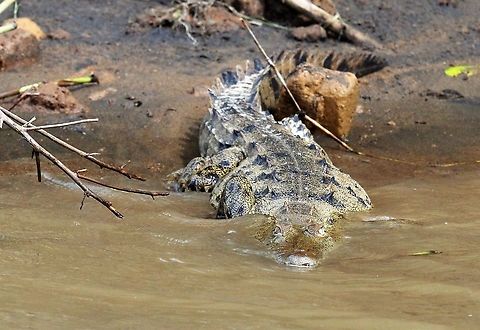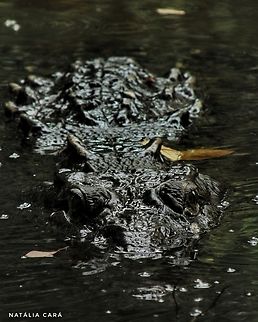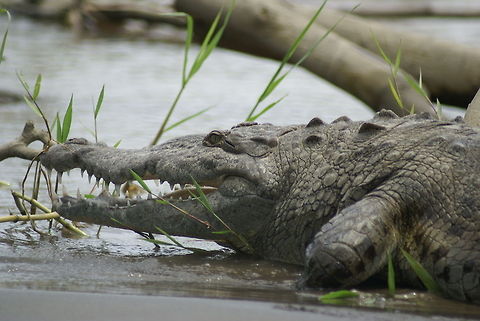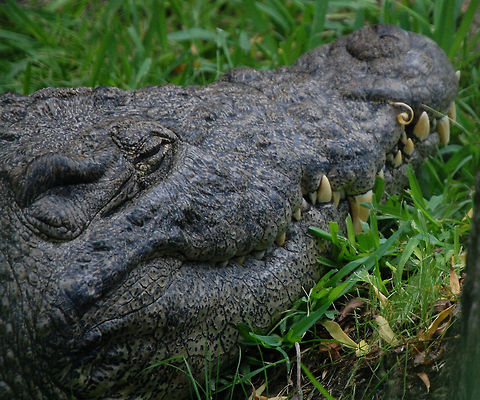
Appearance
Like all crocodilians, the American crocodile is a quadruped, with four short, splayed legs, a long, powerful tail and a scaly hide with rows of ossified scutes running down its back and tail. Its snout is elongated and includes a strong pair of jaws. Its eyes have nictitating membranes for protection along with lachrymal glands, which produce tears.The nostrils, eyes, and ears are situated on the top of its head, so the rest of the body can be concealed underwater for surprise attacks. Camouflage also helps them prey on food. The snout is relatively longer and narrower than the American alligator although broader on average than the Orinoco crocodile. American crocodiles are also paler and more grayish than the relatively dark-hued alligator. This crocodile species normally crawl on their belly, but they can also "high walk". Larger specimens can charge up to 10 miles per hour . They can swim at as much as 20 miles per hour by moving their body and tail in a sinuous fashion, but they cannot sustain this speed.
American crocodiles are more susceptible to cold than American alligators. While an American alligator which can subsist in water of 7.2 °C for some time, an American crocodile in that environment would become helpless and drown. American crocodiles, however, have a faster growth rate than alligators, and are much more tolerant of salt water.

Distribution
''C. acutus'' is the most widespread of the four extant species of crocodiles from the Americas. It inhabits waters such as mangrove swamps, river mouths, fresh waters, and salt lakes and can even be found at sea . Southern Florida, the Greater Antilles and southern Mexico to Colombia and Ecuador. The American crocodile is especially plentiful in Costa Rica....hieroglyph snipped... One of the largest documented populations of American crocodiles is in Lago Enriquillo, a landlocked, hypersaline lake in the Dominican Republic. The species has also been recorded from Jamaica.American crocodiles are saline tolerant, hence their wide distribution throughout the Caribbean. American crocodiles have recently been sighted in Grand Cayman, leading experts to believe that the species may be swimming from Cuba and slowly repopulating Grand Cayman. In addition, an American crocodile/Cuban crocodile hybrid was recently discovered in the Cancun area. The crocodile likely originated in the Zapata Swamp of Cuba and swam to the Yucatan Peninsula. This saline tolerance also allowed the American crocodile to colonize limited portions of the United States Contrary to popular misinformation, the presence of the American alligator is not the reason the American crocodile was unable to populate brackish waters north of Florida, but rather the climate. American crocodiles, unlike American alligators, are extremely susceptible to cold temperatures and live exclusively within tropical waters. During 2009 unusually cold weather within southern Florida resulted in the deaths of approximately 150 wild American crocodiles, including a well known crocodile which inhabited Sanibel Island far north of the crocodile's natural range.
American crocodiles in the United States cohabit with the American alligator, and are primarily found in Everglades National Park, Florida Bay, Biscayne Bay and the Florida Keys from Miami southward. A sizable population occurs near Homestead, Florida, at the Turkey Point Nuclear Generating Station. Some individuals wander northward to warm summer waters and have been sighted in Sarasota County and Palm Beach County. In the summer of 2008, a crocodile was captured in the surf on Isle of Palms, South Carolina.
Crocodiles require consistent tropical temperatures, hence their lack of distribution within the southern United States. They are saltwater-tolerant and have thus been capable of colonizing a multitude of islands within the Caribbean and on some coastal pacific islands as well. They co-exist with the smaller and less territorial American alligator within the Everglades National Park of southern Florida and with the very small Spectacled caiman within Central America. The only other crocodiles present within the American crocodile's range are the smaller and critically endangered Cuban Crocodile, along with the small Morelet's Crocodile in southern Mexico/Guatemala.

Status
Due to hide hunting, pollution, loss of habitat, and removal of adults for commercial farming, the American crocodile is endangered in parts of its range. In 1972, Venezuela banned commercial crocodile skin harvesting for a decade, as a result of 1950s and 1960s overhunting.One thousand to two thousand American crocodiles live in Mexico and Central and South America, but populations are data deficient. The American crocodile is considered a vulnerable species, but has not been assessed since 1996. It has an estimated wild population of 500 to 1,200 in southern Florida. On March 20, 2007, the United States Fish and Wildlife Service declassified the American crocodile as an endangered species, downgrading its status to "threatened"; the reptile remains protected from illegal harassing, poaching or killing under the federal Endangered Species Act.

Food
American crocodile's primary prey throughout life is fish and the relatively narrow snout is indicative of this piscivorous preference. Virtually any freshwater fish is potential prey. In Florida, bass, tarpon and especially mullet appeared to be the primary prey. However, virtually any type of prey is taken given the opportunity. Prey species can range in size from the insects taken by young crocodiles to cattle taken by large adults and includes birds, mammals, turtles, crabs, snails, fish, frogs, and occasionally carrion. Adult American crocodile don't have any natural predators and are capable of eating anything at the water's edge. Reportedly, these crocodiles hunt primarily in the first few hours after nightfall, especially on moonless nights, although will feed at any time of day or night.References:
Some text fragments are auto parsed from Wikipedia.